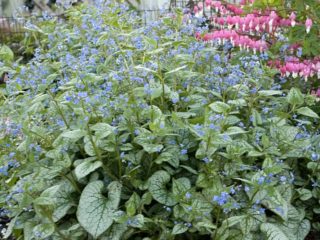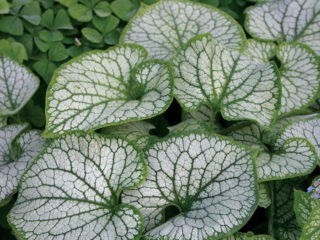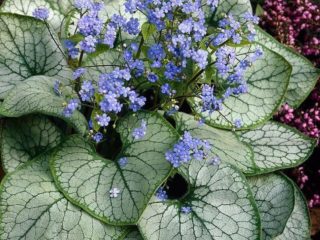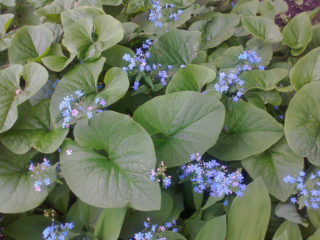Content
Brunner Silver Wings is a representative of the Borage family. It is a herbaceous perennial named after the Swiss traveler Samuel Brunner. There are three types of plants, but only two are grown in culture - large-leaved and Siberian. Large-leaved brunnera is very decorative. Looks good in various compositions and does not require complex care.
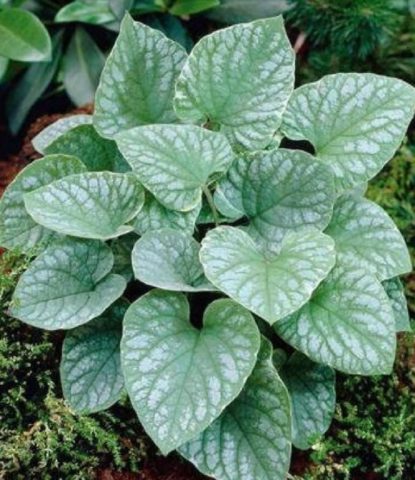
The light tips of the leaves of the Brunnera Silver Wings variety are great for decorating shady corners of the garden.
Description of Brunnera macrophylla Silver Wings
The Latin name of the perennial is Brunnera macrophylla Silver Wing. External description includes:
- Bush dimensions. Low, spreading, in adulthood reaches a height of no more than 25 cm. At the time of flowering, Brunner increases to 40-50 cm. The shoots are branched, slightly pubescent. The root system of Brunnera Silver Wings is powerful.
- Leaf parameters. The plates are large, rough, round or heart-shaped. Slightly pubescent. Leaf diameter is 20 cm. The color is green, with small silver inclusions along the edges. The bottom plate is painted in a grayish tone. The leaves retain their color until frost.Young leaves appear throughout the growing season, which provides the Brunner with an enviable decorative effect.
- Description of flowers. Brunnera Silver Wings blooms with small buds collected in corymbose inflorescences or loose panicles. Diameter no more than 1 cm, color light blue, lilac, light blue. No scent. The beginning of flowering is April or May, depending on the place of cultivation. The plant has a very strong external resemblance to forget-me-nots. Therefore, the popular name for large-leaved brunnera is forget-me-not. Although there is a slight difference that allows you not to confuse these cultures. The spot inside the brunnera flower is white, while that of the forget-me-not is yellow.
- The shape of the fruit of Brunnera Silver Wings, which resembles a nut.
The plant grows slowly, eventually forming luxurious thickets. Brunnera variety Silver Wings is winter-hardy, but does not tolerate hot, dry summers. Withstands temperatures down to -29°C. In one place, the Silver Wings crop can be grown for up to 15 years without replanting.
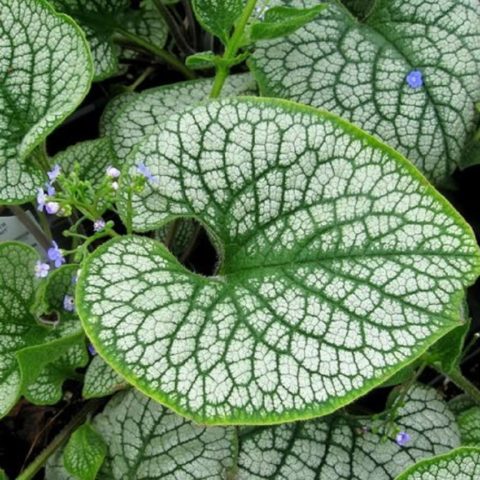
As it grows, the bush fully demonstrates all the characteristics indicated in the description.
Landing
In order for the Silver Wings bush to grow and develop well, it must be planted correctly. To do this, one should take into account the conditions that are comfortable for the culture in nature. It grows in the forest, loves shade and moisture. Based on this, when landing you will have to withstand the following conditions:
- The location must fully comply with the preferences of the perennial. It is recommended to plant large-leaved brunnera in the south in the shade to protect it from the active sun. In cooler regions, partial shade or afternoon shade is suitable. A sunny area can only be chosen on the shore of a reservoir.
- The soil is preferably moist and clayey. The bush grows well on heavy loam.This is a big advantage of brunnera over other plants. Where many crops are unable to grow well, Silver Wings will help improve problem areas of the garden. She is not afraid of fungal diseases from waterlogged soil or lack of sun. In soil that is too rich, especially fertilized with organic matter, intensive and prolonged leaf growth occurs. This negatively affects the rhythm of seasonal development of the crop.
- Planting dates are at the end of July or beginning of August. Spring is a riskier time for an event. During this period the plant is very vulnerable. If you need to plant Brunnera in the spring, then this is only possible with a large lump of earth.
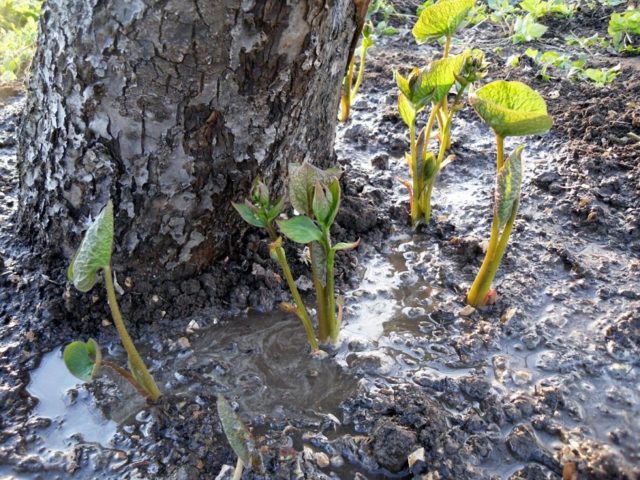
A place under a tree will be very successful, so all conditions will be met
The procedure is simple and can be performed by a gardener with any experience. It is best to schedule the landing in the evening or choose a cloudy day. Algorithm:
- select a healthy faded bush;
- water it, dig it up;
- cut off the ground part of the brunnera;
- clean the roots from the soil;
- cut off rotten or damaged parts;
- soak the root system in water;
- prepare planting holes;
- divide the rhizome according to its natural collapse;
- plant the cuttings in a new place;
- water the bushes.
If you cannot divide the bush by hand, you can use a sterile, sharp knife. Each division must have a regeneration point and part of the rhizome. It is recommended to mulch the planting site.
Care
Any plant in the garden requires care. The decorativeness of the bush depends on what care is provided to the large-leaved brunnera. The culture is considered unpretentious; there is no need to do any special procedures.
Key points for caring for the Silver Wings variety:
- Watering. The plant does not need regular moisture. The exception is hot, dry months, when you need to monitor the condition of the leaves. They will immediately show when it is time to water the bush. The records will begin to droop. If Brunnera grows on the shore of a pond or in partial shade, then it feels good without watering until autumn.
- Weeding. A very important event for culture. Neighborhood with weeds is unacceptable for her. In this case, you cannot loosen the soil. The roots are located close to the surface. Any careless movement will lead to injury to the root system.
- Mulching. It will greatly help protect the roots from heat and conserve moisture.
- Feeding. The Silver Wings variety does not require regular nutrition. It is enough to feed the plant in early spring to stimulate vegetation. You can sprinkle granular complex fertilizer on the snow.
Brunnera largeleaf Silver Wings does not lose its decorative effect throughout the season. The bush constantly renews its foliage and looks very fresh.
Diseases and pests
Problems with the plant can only appear in rainy, cool summers. If there is an excess of moisture, the brunner is susceptible to brown spot or powdery mildew.
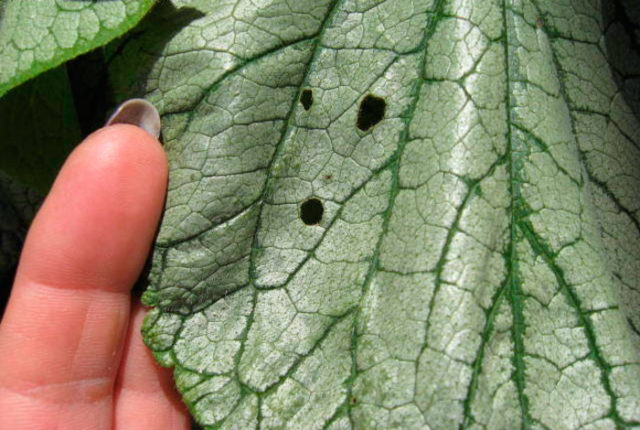
The appearance of spots on the leaves is a signal to start treating the flower.
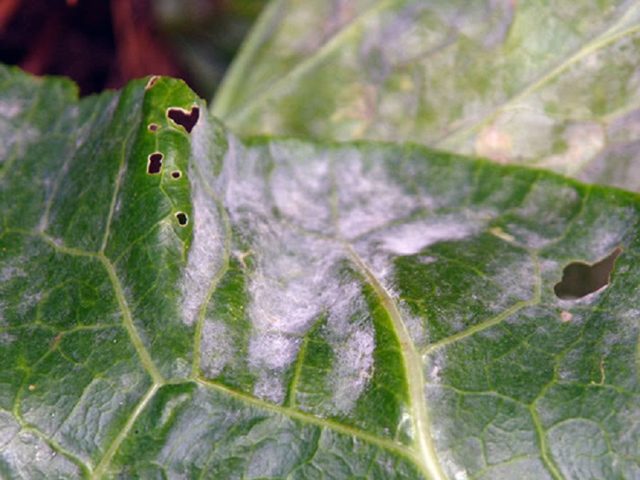
A strong spread of fungal infection can destroy the flower
Diseased parts must be removed and the bush treated with a fungicide. Under such weather conditions, preventive treatments with phytosporin should be carried out at intervals of 2 weeks.
Whiteflies and aphids are considered dangerous pests. If parasites are detected, you need to treat the plant with Actellik or Karbofos. You should also combat the spread of ants in the area.
Trimming
Regular pruning of large-leaved brunnera is not necessary.The leaves do not lose their decorative appearance during the growing season. But they do not die off on their own before the onset of winter. At this time, you will have to cut them to a height of no more than 10 cm from the ground.
Preparing for winter
The plant does not require any special preparation for winter. The frost resistance of Brunnera allows the variety to be grown without shelter. It is enough to cut off the ground part. Then mulch the bush with humus, compost or peat.
Reproduction
Variegated forms of brunners, which include Silver Wings, are propagated by vegetative methods. These include dividing the bush. The best time for the procedure is when the flowering period ends. In August, the formation of future shoots is already taking place, so the end of summer is considered the most successful for planting cuttings.
There is a sexual method of propagation of Brunnera - by seeds. A very painstaking technique due to the small size of the seeds and the mandatory stratification procedure. The grains ripen by the end of July. To ensure good germination, you will need to sow before winter. After 3-4 months of natural stratification, you can wait for seedlings. For spring sowing, it is necessary to place the planting material in the refrigerator for the same period of time. Gardeners are in no hurry to practice sowing Brunnera variety Silver Wings. The plant reproduces well by dividing the bush. Self-seeding is also not a very rare occurrence for this variety.
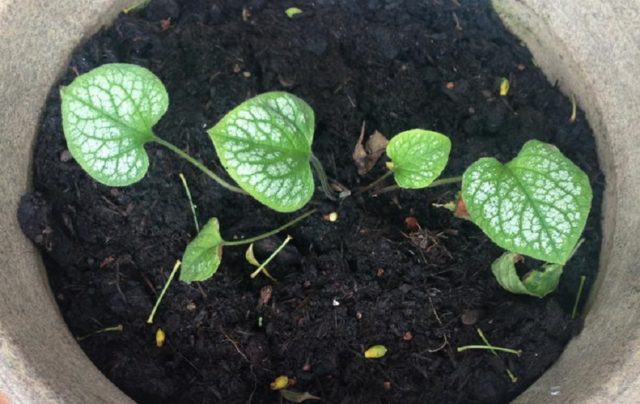
You can grow cuttings in pots and then transplant them to a permanent place
Conclusion
Brunnera Silver Wings is a very decorative crop, especially for shady areas of the garden. It will allow you to decorate problem areas where other species are not able to develop well. The variety can be grown independently, guided by the recommendations of experts and reviews of gardeners.
Reviews
Irina Leonidovna Tsurkan, 39 years old, Novocherkassk
